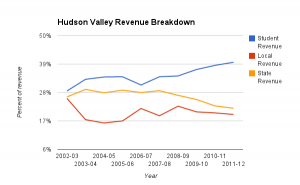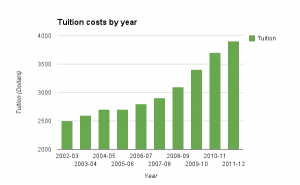The Valley Tally: Counting the college’s cash flow
Pat Gareau, Creative Editor
During the 2013-2014 school year, Hudson Valley will spend over $110 million to operate the college. The majority of this money comes from three general categories of revenue: state aid, local chargebacks and tuition from students.
Over the past ten years, with state aid and local contributions declining, students have had to pay a higher share through tuition increases.
Funding from the local level will be a challenge for the school in coming years with a changed formula threatening to significantly decrease the amount that local counties will pay Hudson Valley for educating their residents.
As the college’s sponsor, Rensselaer County currently pays the school about $1,500 dollars for each resident enrolled at Hudson Valley full time. Meanwhile, other counties pay over $2,400 to Hudson Valley for each resident. Under the new formula, counties will not have to pay any more than the sponsor does per student.
With over 70 percent of its students coming from outside of Rensselaer County, losing $900 in funding for each of these students would put the college in a difficult financial position.
If the new law took effect fully and immediately, the loss of revenue to Hudson Valley from local counties would be over six million dollars. However, the new chargeback rate will be introduced in phases and the decrease in rates for local counties will happen incrementally.
Hudson Valley will be proposing an increased sponsor contribution to the Rensselaer County Legislature so that the lost revenue from other local counties will be minimized.
Hudson Valley’s Sources of Revenue: The rising share of tuition
The funding system for community colleges was originally designed for the state, local, and student shares to be equal at 33 percent each. State aid has been under 30 percent at all times in the last decade and has declined in the last five years to the current rate of 22.6 percent.
Local revenue as a percentage of total college funds was at 25 percent in 2002-03, then declined sharply to around 15 percent the following year. Since then it has increased but still remains low, at 19.6 percent.
Meanwhile, the student’s share has gone steadily higher. In 2002-03, tuition revenue accounted for less than 30 percent of the school’s funds. At that time, tuition was $2,350 per year for full time students.
Now, with county and state funding at low levels, tuition revenue accounts for 37.2 percent of the total operating budget. Our current rate of $3,980 per year represents a nearly 70 percent increase in tuition over that time period.
If the trend of tuition increase continues at the same rate, HVCC full time students will pay over $6,500 per year in the year 2025.
Joel Fatato, Vice President of Finance at Hudson Valley, considers affordability a high priority. Despite recent increases, Hudson Valley’s tuition remains in the middle range for SUNY community colleges. He hopes that higher levels of state and local funding in the future will slow the rate of increased costs to students.
With regard to this years budget, Fatato said, “It is our intent not to increase tuition.”
Working with local government
Fatato is hoping to see a similar increase in state aid to the last few years when the assembly and senate release their budget bills on March 12th.
He is also optimistic that Rensselaer County will work with the college and raise their rate of contributions. On Wednesday, representatives from Hudson Valley will meet with the County Legislature to start discussions.
On Rensselaer increasing the sponsorship rate, Kathy Jimino, Rensselaer County Executive, said, “It’s a difficult thing to come up with money for just about anything.”
Jimino explained that a huge majority of the county’s budget goes to programs mandated by the state, such as medicaid. With the 10 percent of the budget that is discretionary, funding for Hudson Valley has to compete with other non-mandatory programs like senior services, roads and economic development.
It becomes even more difficult for the county to find more money because raising taxes above current levels would make life difficult for residents. According to Jimino, upstate New York local taxes are 80 percent higher than the national average.
Jimino values Hudson Valley as an important entity within the county. Hudson Valley and Rensselaer County are going to have to negotiate from their different perspectives in order to come to terms on a plan for future funding.
“The lens from which the college views the world will be different,” said Jimino.
Keeping quality with uncertain revenue
According to Fatato, while the plan is to keep the budget for next year at the same level it is this year, a total of $110,150,457 including grants, this is already a 3.4 percent decrease from the 2012-13 budget.
Among the cuts in the 2013-14 budget were layoffs and unfilled vacancies. There are currently close to 100 unfilled vacancies. This is in part due to a drop in enrollment after a period of rapid growth from 2008 to 2011. Fatato explained that during the recession, community colleges experienced higher enrollment numbers because they offer affordable programs.
In a 2012 speech to the Rensselaer County Legislature, Hudson Valley President Drew Matonak said, “As I have told our employees, we are in a ‘new reality,’ and we must adjust to our current conditions.”
“We’ve been extremely conservative in budgeting,” said Fatato. The school’s budget has grown at an average of .6 percent over the last five years.
Hudson Valley’s finances are intertwined in a web of federal, state and local governments. The school works closely with government officials to maintain its mission of quality and affordable education.
“We will not diminish academic quality or student services under any condition,” said Fatato.
In order to maintain quality in the context of uncertain revenues, it seems likely that the trend of increasing tuition will continue for the foreseeable future. Even if Rensselaer County can find money to raise their sponsor contribution, fully closing the gap caused by the new chargeback formula will be difficult.



